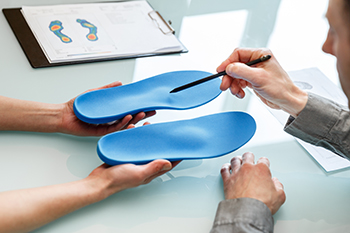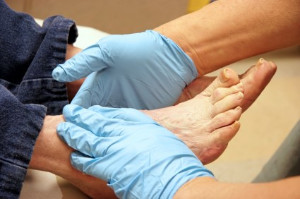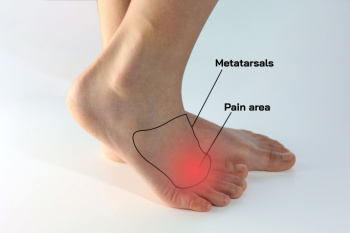Connect With Us
Blog
Items filtered by date: July 2024
Caring for Blisters on the Foot

There are many causes for blisters, which are small sacs of fluid that form on the body. One of the main causes of blisters on the feet is new, tight, or ill-fitting shoes. The harder areas of the shoe can rub against your heels, soles, and toes, and if the motion is repeated for long periods, blisters often will form. These become very painful, especially if you continue the activity. Excessive moisture or perspiration, more often in warmer weather, also may cause blisters. There are a few precautions you can take to prevent blisters. Keeping the feet dry and putting powder on them to reduce sweating, and wearing moisture-wicking socks can help. Wearing softer, more flexible shoes can reduce the chances of blister formation, and reducing your activity for a few days will allow them to heal on their own. If a blister pops open, is extremely large, or won’t heal, it is suggested that you seek the professional care of a podiatrist who can safely drain the area and help reduce the chance of infection.
Blisters are prone to making everyday activities extremely uncomfortable. If your feet are hurting, contact Stephen Boykins, DPM of SoCal Podiatry, P.C.. Our doctor can provide the care you need to keep you pain-free and on your feet.
Foot Blisters
Foot blisters develop as a result of constantly wearing tight or ill-fitting footwear. This happens due to the constant rubbing from the shoe, which can often lead to pain.
What Are Foot Blisters?
A foot blister is a small fluid-filled pocket that forms on the upper-most layer of the skin. Blisters are filled with clear fluid and can lead to blood drainage or pus if the area becomes infected.
How Do Blisters Form?
Blisters on the feet are often the result of constant friction of skin and material, usually by shoe rubbing. Walking in sandals, boots, or shoes that don’t fit properly for long periods of time can result in a blister. Having consistent foot moisture and humidity can easily lead to blister formation.
Prevention & Treatment
It is important to properly care for the affected area in order to prevent infection and ease the pain. Do not lance the blister and use a Band-Aid to provide pain relief. Also, be sure to keep your feet dry and wear proper fitting shoes. If you see blood or pus in a blister, seek assistance from a podiatrist.
If you have any questions, please feel free to contact our offices located in Downey and Moreno Valley, CA . We offer the newest diagnostic and treatment technologies for all your foot care needs.
Charcot-Marie-Tooth Disease Affects Feet
 Charcot-Marie-Tooth, or CMT, disease is a hereditary condition that affects the ability of the peripheral nerves to communicate with the muscles, joints, and skin. A progressive condition, Charcot-Marie-Tooth disease affects the lower extremities first, leading to muscle weakness and atrophy, particularly in the legs and feet. Symptoms such as balance difficulties, high foot arches, twisted ankles, and foot slapping can make walking and finding appropriate footwear challenging. With no cure available, managing CMT involves stretching and exercise techniques to preserve muscle strength and flexibility, while orthotic devices and braces can provide much-needed support for improved mobility. In severe cases, surgery might be necessary to correct bone deformities. Consulting a podiatrist can be particularly beneficial in managing CMT-related foot issues, offering personalized treatments and recommendations to enhance quality of life. If you are suffering from a rare foot condition, such as CMT, it is suggested that you schedule an appointment with a podiatrist for guidance in managing its symptoms.
Charcot-Marie-Tooth, or CMT, disease is a hereditary condition that affects the ability of the peripheral nerves to communicate with the muscles, joints, and skin. A progressive condition, Charcot-Marie-Tooth disease affects the lower extremities first, leading to muscle weakness and atrophy, particularly in the legs and feet. Symptoms such as balance difficulties, high foot arches, twisted ankles, and foot slapping can make walking and finding appropriate footwear challenging. With no cure available, managing CMT involves stretching and exercise techniques to preserve muscle strength and flexibility, while orthotic devices and braces can provide much-needed support for improved mobility. In severe cases, surgery might be necessary to correct bone deformities. Consulting a podiatrist can be particularly beneficial in managing CMT-related foot issues, offering personalized treatments and recommendations to enhance quality of life. If you are suffering from a rare foot condition, such as CMT, it is suggested that you schedule an appointment with a podiatrist for guidance in managing its symptoms.
Some foot conditions may require additional professional care. If you have any concerns, contact Stephen Boykins, DPM of SoCal Podiatry, P.C.. Our doctor can provide the care you need to keep you pain-free and on your feet.
Rare Foot Conditions
The majority of foot conditions are common and can be treated by a podiatrist. Standard diagnostic procedures are generally used to identify specific conditions and treatment can be rendered. A podiatrist also treats rare foot conditions which can be difficult to diagnose and may need extra attention and care.
There are many rare foot conditions that can affect children. Some of these can include:
- Freiberg’s disease
- Kohler’s disease
- Maffucci syndrome
Freiberg’s disease - This can be seen as a deterioration and flattening of a metatarsal bone that exists in the ball of the foot. It typically affects pre-teen and teenage girls, but can affect anyone at any age. Symptoms that can accompany this can be swelling, stiffness, and the patient may limp.
Kohler’s disease - This often targets the bone in the arch of the foot and affects younger boys. It can lead to an interruption of the blood supply which ultimately can lead to bone deterioration. The patient may limp or experience tenderness, swelling, and redness.
Maffucci syndrome - This affects the long bones in a child’s foot leading to the development of abnormal bone lesions. They are benign growths and typically develop in early childhood and the bones may be susceptible to breaking.
A podiatrist can properly diagnose and treat all types of rare foot conditions. If your child is affected by any of these symptoms or conditions, please don’t hesitate to call our office so the correct treatment method can begin.
If you have any questions please feel free to contact our offices located in Downey and Moreno Valley, CA . We offer the newest diagnostic tools and technology to treat your foot and ankle needs.
What Are Diabetic Foot Ulcers?

Diabetic foot ulcers are serious complications of diabetes, characterized by open sores or wounds that typically develop on the feet. They result from poor circulation, nerve damage, also called neuropathy, and impaired immune function associated with diabetes. Treatment involves meticulous wound care, which includes cleaning the ulcer with gentle soap and water, applying antibiotic ointment, and covering it with a sterile dressing. Offloading pressure from the affected foot is important to prevent further irritation and aid healing. Podiatrists can conduct regular exams to monitor ulcers, assess circulation, and provide guidance on footwear and hygiene. Timely intervention can prevent complications such as infections or amputations. If you have diabetes, it is strongly suggested you visit a podiatrist who can help you to manage this condition.
Wound care is an important part in dealing with diabetes. If you have diabetes and a foot wound or would like more information about wound care for diabetics, consult with Stephen Boykins, DPM from SoCal Podiatry, P.C.. Our doctor will assess your condition and provide you with quality foot and ankle treatment.
What Is Wound Care?
Wound care is the practice of taking proper care of a wound. This can range from the smallest to the largest of wounds. While everyone can benefit from proper wound care, it is much more important for diabetics. Diabetics often suffer from poor blood circulation which causes wounds to heal much slower than they would in a non-diabetic.
What Is the Importance of Wound Care?
While it may not seem apparent with small ulcers on the foot, for diabetics, any size ulcer can become infected. Diabetics often also suffer from neuropathy, or nerve loss. This means they might not even feel when they have an ulcer on their foot. If the wound becomes severely infected, amputation may be necessary. Therefore, it is of the upmost importance to properly care for any and all foot wounds.
How to Care for Wounds
The best way to care for foot wounds is to prevent them. For diabetics, this means daily inspections of the feet for any signs of abnormalities or ulcers. It is also recommended to see a podiatrist several times a year for a foot inspection. If you do have an ulcer, run the wound under water to clear dirt from the wound; then apply antibiotic ointment to the wound and cover with a bandage. Bandages should be changed daily and keeping pressure off the wound is smart. It is advised to see a podiatrist, who can keep an eye on it.
If you have any questions, please feel free to contact our offices located in Downey and Moreno Valley, CA . We offer the newest diagnostic and treatment technologies for all your foot care needs.
Do Your Child's Feet Hurt?
Diabetes and Foot Wound Healing
 Diabetes significantly impacts wound healing, particularly in the feet, due to high blood sugar levels that impair circulation and immune response. Diabetes is a chronic condition where the body cannot regulate blood sugar properly, leading to various complications. In diabetics, poor blood circulation reduces the delivery of oxygen and nutrients essential for healing, while neuropathy, or nerve damage, diminishes the sensation, making it harder to notice injuries. As a result, even minor foot wounds can progress to serious ulcers or infections if left untreated. Foot wounds in diabetic patients often occur due to friction, pressure, or minor trauma, exacerbated by poorly fitting shoes or neglect. To prevent and treat these wounds, maintain proper foot hygiene, inspect feet daily for injuries, and manage blood sugar levels rigorously. Wearing well-fitted shoes and avoiding walking barefoot can also help prevent injuries. If you have diabetes and have persistent wounds or complications, it is strongly suggested that you consult a podiatrist. These healthcare providers specialize in diabetic foot care, providing tailored treatment and preventing severe outcomes.
Diabetes significantly impacts wound healing, particularly in the feet, due to high blood sugar levels that impair circulation and immune response. Diabetes is a chronic condition where the body cannot regulate blood sugar properly, leading to various complications. In diabetics, poor blood circulation reduces the delivery of oxygen and nutrients essential for healing, while neuropathy, or nerve damage, diminishes the sensation, making it harder to notice injuries. As a result, even minor foot wounds can progress to serious ulcers or infections if left untreated. Foot wounds in diabetic patients often occur due to friction, pressure, or minor trauma, exacerbated by poorly fitting shoes or neglect. To prevent and treat these wounds, maintain proper foot hygiene, inspect feet daily for injuries, and manage blood sugar levels rigorously. Wearing well-fitted shoes and avoiding walking barefoot can also help prevent injuries. If you have diabetes and have persistent wounds or complications, it is strongly suggested that you consult a podiatrist. These healthcare providers specialize in diabetic foot care, providing tailored treatment and preventing severe outcomes.
Diabetic foot care is important in preventing foot ailments such as ulcers. If you are suffering from diabetes or have any other concerns about your feet, contact Stephen Boykins, DPM from SoCal Podiatry, P.C.. Our doctor can provide the care you need to keep you pain-free and on your feet.
Diabetic Foot Care
Diabetes affects millions of people every year. The condition can damage blood vessels in many parts of the body, especially the feet. Because of this, taking care of your feet is essential if you have diabetes, and having a podiatrist help monitor your foot health is highly recommended.
The Importance of Caring for Your Feet
- Routinely inspect your feet for bruises or sores.
- Wear socks that fit your feet comfortably.
- Wear comfortable shoes that provide adequate support.
Patients with diabetes should have their doctor monitor their blood levels, as blood sugar levels play such a huge role in diabetic care. Monitoring these levels on a regular basis is highly advised.
It is always best to inform your healthcare professional of any concerns you may have regarding your feet, especially for diabetic patients. Early treatment and routine foot examinations are keys to maintaining proper health, especially because severe complications can arise if proper treatment is not applied.
If you have any questions please feel free to contact our offices located in Downey and Moreno Valley, CA . We offer the newest diagnostic and treatment technologies for all your foot and ankle needs.
Nerve Pain in the Foot

Experiencing nerve pain in your foot can impact your daily activities and overall quality of life. One common cause of such pain is Morton's neuroma, a condition where a nerve in the ball of the foot becomes swollen or thickened. This often results from wearing shoes that squeeze the toes together for extended periods, such as high-heeled, tight, or narrow footwear. Symptoms of Morton's neuroma can include a sharp, burning pain in the foot that intensifies with walking and a sensation of a small lump in the ball of the foot, typically between the third and fourth toes. Diagnosis usually involves a physical exam and may require imaging tests like ultrasound, X-ray, or MRI scans to confirm. Switching to shoes that allow ample room for the toes and reducing activities that exacerbate the pain may provide relief. If these measures are insufficient, special pads or devices to spread the toes, steroid injections, or in severe cases, surgery, may be recommended to alleviate symptoms. Persistent nerve pain should not be ignored, as early intervention can prevent further complications. If you are experiencing such pain, consulting a podiatrist is suggested for a comprehensive evaluation and appropriate treatment plan.
Morton’s neuroma is a very uncomfortable condition to live with. If you think you have Morton’s neuroma, contact Stephen Boykins, DPM of SoCal Podiatry, P.C.. Our doctor will attend to all of your foot care needs and answer any of your related questions.
Morton’s Neuroma
Morton's neuroma is a painful foot condition that commonly affects the areas between the second and third or third and fourth toe, although other areas of the foot are also susceptible. Morton’s neuroma is caused by an inflamed nerve in the foot that is being squeezed and aggravated by surrounding bones.
What Increases the Chances of Having Morton’s Neuroma?
- Ill-fitting high heels or shoes that add pressure to the toe or foot
- Jogging, running or any sport that involves constant impact to the foot
- Flat feet, bunions, and any other foot deformities
Morton’s neuroma is a very treatable condition. Orthotics and shoe inserts can often be used to alleviate the pain on the forefront of the feet. In more severe cases, corticosteroids can also be prescribed. In order to figure out the best treatment for your neuroma, it’s recommended to seek the care of a podiatrist who can diagnose your condition and provide different treatment options.
If you have any questions, please feel free to contact our offices located in Downey and Moreno Valley, CA . We offer the newest diagnostic and treatment technologies for all your foot care needs.

